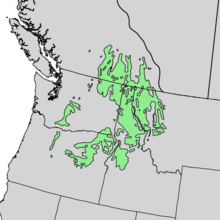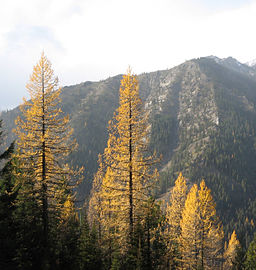
Pseudotsuga menziesii var. glauca, or Rocky Mountain Douglas-fir, is an evergreen conifer native to the interior mountainous regions of western North America, from central British Columbia and southwest Alberta in Canada southward through the United States to the far north of Mexico. The range is continuous in the northern Rocky Mountains south to eastern Washington, eastern Oregon, Idaho, western and south-central Montana and western Wyoming, but becomes discontinuous further south, confined to "sky islands" on the higher mountains in Utah, Colorado, Arizona and New Mexico, with only very isolated small populations in eastern Nevada, westernmost Texas, and northern Mexico. It occurs from 600 m altitude in the north of the range, up to 3,000 m, rarely 3,200 m, in the south. Further west towards the Pacific coast, it is replaced by the related coast Douglas-fir, and to the south, it is replaced by Mexican Douglas-fir in high mountains as far south as Oaxaca. Some botanists have grouped Mexican Douglas-fir with P. menziesii var. glauca, but genetic and morphological evidence suggest that Mexican populations should be considered a different variety.

Larches are deciduous conifers in the genus Larix, of the family Pinaceae. Growing from 20 to 45 metres tall, they are native to the cooler regions of the northern hemisphere, where they are found in lowland forests in the high latitudes, and high in mountains further south. Larches are among the dominant plants in the boreal forests of Siberia and Canada. Although they are conifers, larches are deciduous trees that lose their needles in the autumn.
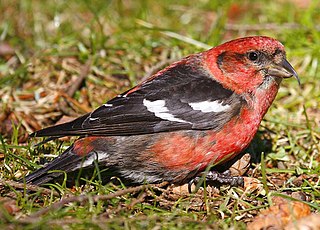
The two-barred crossbill or white-winged crossbill is a small passerine bird in the finch family Fringillidae. It breeds in the coniferous forests of North America and the Palearctic.

Thuja plicata is a large evergreen coniferous tree in the family Cupressaceae, native to the Pacific Northwest of North America. Its common name is western redcedar in the U.S. or western red cedar in the UK, and it is also called pacific red cedar, giant arborvitae, western arborvitae, just cedar, giant cedar, or shinglewood. It is not a true cedar of the genus Cedrus. T. plicata is the largest species in the genus Thuja, growing up to 70 metres (230 ft) tall and 7 metres (23 ft) in diameter. It mostly grows in areas that experience a mild climate with plentiful rainfall, although it is sometimes present in drier areas on sites where water is available year-round, such as wet valley bottoms and mountain streamsides. The species is shade-tolerant and able to establish in forest understories and is thus considered a climax species. It is a very long-lived tree, with some specimens reaching ages of well over 1,000 years.

Pinus contorta, with the common names lodgepole pine and shore pine, and also known as twisted pine, and contorta pine, is a common tree in western North America. It is common near the ocean shore and in dry montane forests to the subalpine, but is rare in lowland rain forests. Like all pines, it is an evergreen conifer.
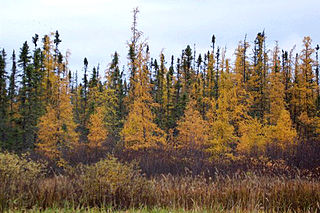
Larix laricina, commonly known as the tamarack, hackmatack, eastern larch, black larch, red larch, or American larch, is a species of larch native to Canada, from eastern Yukon and Inuvik, Northwest Territories east to Newfoundland, and also south into the upper northeastern United States from Minnesota to Cranesville Swamp, West Virginia; there is also an isolated population in central Alaska.

Pseudolarix amabilis is a species of coniferous tree in the pine family Pinaceae. The species is commonly known as golden larch, but being more closely related to Keteleeria, Abies and Cedrus, is not a true larch (Larix). P. amabilis is native to eastern China, occurring in small areas in the mountains of southern Anhui, Zhejiang, Fujian, Jiangxi, Hunan, Hubei and eastern Sichuan, at altitudes of 100–1,500 m (328–4,921 ft). The earliest known occurrences are of compression fossils found in the Ypresian Allenby Formation and mummified fossils found in the Late Eocene Buchanan Lake Formation on Axel Heiberg Island.

Abies grandis is a fir native to the Pacific Northwest and Northern California of North America, occurring at altitudes of sea level to 1,700 metres (5,600 ft). It is a major constituent of the Grand Fir/Douglas Fir Ecoregion of the Cascade Range.

Tsuga mertensiana, known as mountain hemlock, is a species of hemlock native to the west coast of North America, found between Southcentral Alaska and south-central California.

Cupressus arizonica, the Arizona cypress, is a North American species of tree in the cypress family Cupressaceae, native to the southwestern United States and Mexico. Populations may be scattered rather than in large, dense stands.
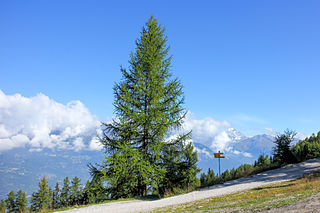
Larix decidua, the European larch, is a species of larch native to the mountains of central Europe, in the Alps and Carpathian Mountains as well as the Pyrenees, with disjunct lowland populations in northern Poland and southern Lithuania. It is widely naturalized in Scandinavia. Its life span has been confirmed to be close to 1000 years but is more often around 200 years. It is claimed that one of the larches planted by the second Duke of Atholl at Dunkeld in 1738 is still standing.

The International Larix Arboretum is a small arboretum of 1.2 acres (4,900 m2) dedicated to the scientific study of the larch (Larix) species. It is located within the Coram Experimental Forest, 30 yards SE of the Hungry Horse Ranger station at 10 Hungry Horse Drive Hungry Horse, Montana. The Arboretum is open to the public, without charge, during daylight hours from April to October.

Larix lyallii, the subalpine larch, or simply alpine larch, is a deciduous, coniferous tree native to northwestern North America. It lives at high altitudes, from 1,500 to 2,900 meters, in the Rocky Mountains of Idaho, Montana, British Columbia, and Alberta. There is a disjunct population in the Cascade Range of Washington.

Larix kaempferi, the Japanese larch or karamatsu in Japanese, is a species of larch native to Japan, in the mountains of Chūbu and Kantō regions in central Honshū.

Juniperus occidentalis, known as the western juniper, is a shrub or tree native to the Western United States, growing in mountains at altitudes of 800–3,000 meters (2,600–9,800 ft) and rarely down to 100 m (330 ft). It is listed as Least Concern on the IUCN Red List because it is a widespread species with an increasing population.

Larix gmelinii, the Dahurian larch or Gmelin larch, is a species of larch native to eastern Siberia and adjacent northeastern Mongolia, northeastern China (Heilongjiang), South Korea and North Korea.

Larix griffithii, the Sikkim larch, is a species of larch, native to the eastern Himalaya in eastern Nepal, Sikkim, western Bhutan and southwestern China, growing at 1,800–4,100 metres (5,900–13,500 ft) in altitude.
Forest migration is the movement of large seed plant dominated communities in geographical space over time.

Assisted migration is the movement of populations or species by humans from one territory to another in response to climate change. This is the definition offered in a nontechnical document published by the United States Forest Service in 2023, suggesting that this form of climate adaptation "could be a proactive, pragmatic tool for building climate resilience in our landscapes."

